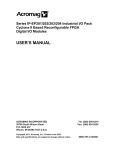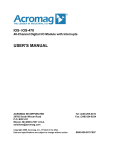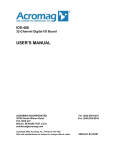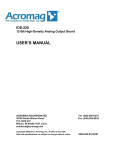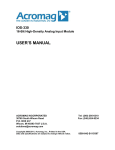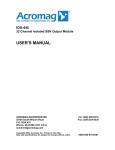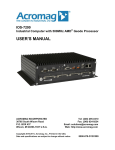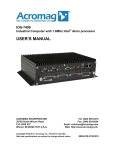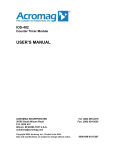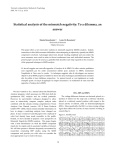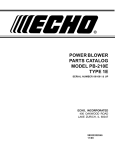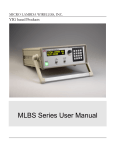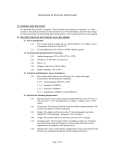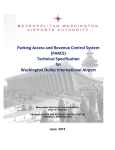Download IOS-409 User`s Manual
Transcript
IOS-409 24-Channel Differential Digital I/O Board USER’S MANUAL ACROMAG INCORPORATED 30765 South Wixom Road P.O. BOX 437 Wixom, MI 48393-7037 U.S.A. [email protected] Copyright 2009, Acromag, Inc., Printed in the USA. Data and specifications are subject to change without notice. Tel: (248) 295-0310 Fax: (248) 624-9234 8500-844-B11C007 SERIES IOS-409 I/O SERVER MODULE 24-CHANNEL DIFFERENTIAL DIGITAL I/O MODULE ___________________________________________________________________________________________ The information contained in this manual is subject to change without notice. Acromag, Inc. makes no warranty of any kind with regard to this material, including, but not limited to, the implied warranties of merchantability and fitness for a particular purpose. Further, Acromag, Inc. assumes no responsibility for any errors that may appear in this manual and makes no commitment to update, or keep current, the information contained in this manual. No part of this manual may be copied or reproduced in any form, without the prior written consent of Acromag, Inc. Table of Contents 1.0 GENERAL INFORMATION........................................... KEY IOS-409 FEATURES............................................. I/O SERVER MODULE SOFTWARE LIBRARY........... 2.0 PREPARATION FOR USE............................................ UNPACKING AND INSPECTION.................................. BOARD CONFIGURATION........................................... CONNECTORS............................................................. IOS Field I/O Connector (P2)..................................... I/O Noise and Grounding Considerations.................. 3.0 PROGRAMMING INFORMATION................................. ADDRESS MAPS.......................................................... Control Register............................………………….... Input/Output Channel Registers................................ Direction Control Registers........................................ Interrupt Enable Register……………………………… Interrupt Type Configuration Register........................ Interrupt Status Register................................…........ Interrupt Polarity Register.......................................... Interrupt Vector Register..........................….............. IOS Identification Space............................................ IOS-409 PROGRAMMING CONSIDERATIONS............ I/O Handshake Operation………………………….….. Programming Interrupts.....................................….... 4.0 THEORY OF OPERATION........................................... FIELD INPUT/OUTPUT SIGNALS................................. EIA-RS485 AND RS422 SERIAL INTERFACE…….….. 5.0 SERVICE AND REPAIR................................................ SERVICE AND REPAIR ASSISTANCE........................ PRELIMINARY SERVICE PROCEDURE...................... 6.0 SPECIFICATIONS......................................................... PHYSICAL……………………........................................ ENVIRONMENTAL........................................................ EIA-RS485/RS422 TRANSCEIVERS............................ Page 2 2 3 3 3 3 3 3 4 4 4 5 5 5 5 6 6 6 6 6 7 7 8 9 9 9 9 9 9 10 10 10 10 DRAWINGS IOS-409 BLOCK DIAGRAM................….......... IOS-409 EXAMPLE I/O CONNECTIONS…….. IOS-409 TERMINATION RESISTOR LOCATION…… Page 11 12 13 IMPORTANT SAFETY CONSIDERATIONS It is very important for the user to consider the possible adverse effects of power, wiring, component, sensor, or software failures in designing any type of control or monitoring system. This is especially important where economic property loss or human life is involved. It is important that the user employ satisfactory overall system design. It is agreed between the Buyer and Acromag, that this is the Buyer's responsibility. -2- 1.0 GENERAL INFORMATION The I/O Server Module (IOS) Series IOS-409 module is a 24channel differential digital input/output board with interrupts. This model allows channels to be programmed as input or output on a bit basis, in any combination up to 24 channels. All channels can be programmed to generate Change-Of-State (COS), Low, or High level transition interrupts. Each channel uses a robust RS485/RS422 transceiver which permits half duplex bi-directional data transfer (one direction at a time). The use of differential data transmission allows reliable transmission of data at high rates over up to 4000 meter distances and through noisy environments. Differential transmission nullifies the effects of ground shifts and noise signals which appear as common-mode voltages on the line. The IOS-409 model temperature range is (-40 C to +85 C). Four units mounted on a carrier board provide up to 96 I/O points per 6U-VMEbus system slot. Since each channel can be independently programmed as an input or output, loopback monitoring is possible. A channel programmed as an input can be used to monitor another channel programmed as an output. The IOS-409 utilizes state of the art Surface-Mounted Technology (SMT) to achieve its high channel density and is an ideal choice for a wide range of industrial control and monitor applications that require high-density, high-reliability, and highperformance at a low cost. Important Note: The following IOS model are accessories to the IOS Server Models: IOS-7200, IOS-7200-WIN, IOS-7400, and IOS-7400-WIN; which are cULus Listed. This equipment is suitable for use in Class I, Division 2, Groups A, B, C, and D or non-hazardous locations only. KEY IOS-409 FEATURES High Channel Count - Interfaces with up to 24 input/output points. Four units mounted on a carrier board provide up to 96 input and/or output channels in a single system slot. Input and output channels may be intermixed in any combination. The input circuitry of a single channel can also be used to monitor the output state of a different channel to efficiently implement “loopback” output control. Long Distance Data Transmission - Data transmission with up to 32 nodes and up to 4000 feet is possible. Robust RS485/RS422 Transceivers - The IOS-409 is designed for electrically harsh environments. All differential I/O channels are protected against electrostatic discharge (ESD), electrical fast transient (EFT), and electromagnetic interference (EMI). Programmable Change-of-State/Level Interrupts Interrupts are software programmable for any bit Change-OfState or Level on an individual channel basis. Socketed Termination Resistors - The network termination resistors are installed in sockets on the board and may be easily inserted or removed as required. No Configuration Jumpers or Switches - All configuration is performed through software commands with no internal jumpers to configure or switches to set. Power Up & System Reset is Failsafe - For safety, all channels are configured as input upon power-up and after a system reset. SERIES IOS-409 I/O SERVER MODULE 24-CHANNEL DIFFERENTIAL DIGITAL I/O MODULE __________________________________________________________________________________________ Output Channels With Read Back - The differential output channel registers can be read back to verify programmed logic levels. Conduction Cooled Module - I/O modules employ advanced thermal technologies. A thermal pad and module cover wicks heat away from the module and transfers the energy to a heat spreading friction plate. Heat moves to the enclosure walls where it is dissipated by the external cooling fins. BOARD CONFIGURATION Power should be removed from the board when installing IOS modules, cables, termination panels, and field wiring. Refer to the following discussion for configuration and assembly instructions. Model IOS-409 I/O Boards have no jumpers or switches to configure--interrupts are configured through software commands. IOS MODULE Win32 DRIVER SOFTWARE CONNECTORS Acromag provides a software product (sold separately) to facilitate the development of Windows Embedded Standard applications interfacing with I/O Server Modules installed on Acromag Industrial I/O Server systems. This software (Model IOSSW-DEV-WIN) consists of a low-level driver and Windows 32 Dynamic Link Libraries (DLLS) that are compatible with a number of programming environments including Visual C++, Visual Basic.NET, Borland C++ Builder and others. The DLL functions provide a high-level interface to the IOS carrier and modules eliminating the need to perform low-level reads/writes of registers, and the writing of interrupt handlers. IOS Field I/O Connector (P2) P2 provides the field I/O interface connector for mating IOS modules to the carrier board. P2 is a 50-pin female receptacle header (AMP 173279-3 or equivalent) which mates to the male connector of the carrier board (AMP 173280-3 or equivalent). This provides excellent connection integrity and utilizes goldplating in the mating area. The field and logic side connectors are keyed to avoid incorrect assembly. P2 pin assignments are unique to each IOS model (see Table 2.1) and normally correspond to the pin numbers of the field-I/O interface connector on the carrier board (you should verify this for your carrier board). When reading Table 2.1 note that channel designations are abbreviated to save space. For example, channel 0 is abbreviated as I/O00+ and I/O00- for the + and - connections, respectively. IOS MODULE LINUX SOFTWARE Acromag provides a software product (sold separately) consisting of Linux software. This software (Model IOSSW-APILNX) is composed of Linux libraries designed to support applications accessing I/O Server Modules installed on Acromag Industrial I/O Server systems The software is implemented as a library of “C” functions which link with existing user code Table 2.1: IOS-409 Field I/O Pin Connections (P2) 2.0 PREPARATION FOR USE Pin Description I/O00+ I/O00I/O01+ I/O01I/O02+ I/O02I/O03+ I/O03I/O04+ I/O04I/O05+ I/O05I/O06+ I/O06I/O07+ I/O07I/O08+ I/O08I/O09+ I/O09I/O10+ I/O10I/O11+ I/O11I/O12+ UNPACKING AND INSPECTION Upon receipt of this product, inspect the shipping carton for evidence of mishandling during transit. If the shipping carton is badly damaged or water stained, request that the carrier's agent be present when the carton is opened. If the carrier's agent is absent when the carton is opened and the contents of the carton are damaged, keep the carton and packing material for the agent's inspection. For repairs to a product damaged in shipment, refer to the Acromag Service Policy to obtain return instructions. It is suggested that salvageable shipping cartons and packing material be saved for future use in the event the product must be shipped. This board is physically protected with packing material and electrically protected with an anti static bag during shipment. However, it is recommended that the board be visually inspected for evidence of mishandling prior to applying power. The board utilizes static sensitive components and should only be handled at a staticsafe workstation. -3- Number 1 2 3 4 5 6 7 8 9 10 11 12 13 14 15 16 17 18 19 20 21 22 23 24 25 Pin Description I/O12I/O13+ I/O13I/O14+ I/O14I/O15+ I/O15I/O16+ I/O16I/O17+ I/O17I/O18+ I/O18I/O19+ I/O19I/O20+ I/O20I/O21+ I/O21I/O22+ I/O22I/O23+ I/O23RESERVED GND Number 26 27 28 29 30 31 32 33 34 35 36 37 38 39 40 41 42 43 44 45 46 47 48 49 50 SERIES IOS-409 I/O SERVER MODULE 24-CHANNEL DIFFERENTIAL DIGITAL I/O MODULE __________________________________________________________________________________________ Table 3.1: IOS-409 I/O Space Address (Hex) Memory Map HIGH LOW Base HIGH Byte LOW Byte Base Addr.+ D15 D08 D07 D00 Addr.+ 01 Control Register 00 03 Input/Output Input/Output Channel Reg B Channel Reg A CH15 CH08 CH07 CH00 02 05 Input/Output Not Used2 Channel Reg C CH23 CH16 04 07 Direction Control Direction Control Register B Register A CH15 CH08 CH07 CH00 06 09 Direction Control Not Used2 Register C CH23 CH16 08 0B R/W - Interrupt R/W - Interrupt Enable Register B Enable Register A CH15 CH08 CH07 CH00 0A 0D R/W - Interrupt Not Used2 Enable Register C CH23 CH16 0C 0F R/W - Interrupt R/W - Interrupt Type Register B Type Register A CH15 CH08 CH07 CH00 0E 11 R/W - Interrupt Not Used2 Type Register C CH23 CH16 10 13 R/W - Interrupt R/W - Interrupt Status Register B Status Register A CH15 CH08 CH07 CH00 12 15 R/W - Interrupt Not Used2 Status Register C CH23 CH16 14 17 R/W - Interrupt R/W - Interrupt Polarity Register B Polarity Register A CH15 CH08 CH07 CH00 16 19 R/W - Interrupt Not Used2 Polarity Register C CH23 CH16 18 1B R/W - Interrupt Not Used2 Vector Register1 1A 1D 1C NOT USED2 7F 7E I/O Noise and Grounding Considerations The IOS-409 is non-isolated between the logic and field I/O grounds since output common is electrically connected to the IOS module ground. Consequently, the field I/O connections are not isolated from the carrier board and backplane. Two ounce copper ground plane foil has been employed in the design of this model to help minimize the effects of ground bounce, impedance drops, and switching transients. However, care should be taken in designing installations without isolation to avoid noise pickup and ground loops caused by multiple ground connections. To minimize high levels of EMI the signal ground connection at the field I/O port (pin 50) should be used to provide a path for induced common-mode noise and currents. The ground path provides a low-impedance path to reduce emissions. EIA RS485/RS422 communication distances are generally limited to less than 4000 feet. To minimize transmission-line problems, all nodes connected to the cable must use minimum stub length connections. The optimal configuration for the RS485/RS422 bus is a daisy-chain connection from node 1 to node 2 to node 3 to node n. The bus must form a single continuous path, and the nodes in the middle of the bus must not be at the ends of long branches, spokes, or stubs. See IOS-409 Example I/O Connections for example connection and termination practices. Transmission line signal reflections can be minimized with proper termination. The EIA RS485/RS422 standard allows up to 32 driver/receivers to be connected to a single bus. Termination resistors should only be used at the two extreme ends of the bus and not at each of the nodes of the bus. 3.0 PROGRAMMING INFORMATION ADDRESS MAPS This board is addressable in the I/O Server Module space to control the data transfer, and steering logic of the 24 EIA RS485/RS422 serial ports. The I/O space may be as large as 64, 16-bit words (128 bytes) using address lines A1..A6, but the IOS-409 only uses a portion of this space. The I/O space address map for the IOS-409 is shown in Table 3.1. Notes (Table 3.1): 1. The upper 8 bits (even byte) of this register are not driven upon on interrupt select cycle. Pullups on the carrier board data bus will cause these bits to always read high (1‟s). 2. The IOS will respond to addresses that are "Not Used" with an active IOS module acknowledge ACK~. Data read at “Not Used” addresses will be driven low. The base address for the IOS module I/O space (see your carrier board instructions) must be added to the addresses shown in Table 3.1 to properly access the I/O space. Accesses can be performed on an 8-bit (D08[EO]), or 16-bit (D16) word basis. -4- SERIES IOS-409 I/O SERVER MODULE 24-CHANNEL DIFFERENTIAL DIGITAL I/O MODULE __________________________________________________________________________________________ the corresponding input channel to generate an interrupt. Only those channels configured as inputs can generate interrupts. Control Register (Write) - (Base + 00H) This read/write register is used to issue a software reset. Bit0 when set to a logic high will perform a software reset. When read this register will return random values. The Interrupt Enable register at the carrier‟s base address + offset 0A is used to control channels 00 through 07. For example, channel 00 is controlled via data bit-0 as seen in the table below. Registers for Channels 15 to 08 and Channels 23 to 16 are accessed similarly at offsets 0B and 0C hex, respectively. Input/Output Channel Registers (Read/Write) - (Base + 02, 03, 04) Twenty-four possible input/output channels numbered 0 through 23 may be individually accessed via these registers. The Input/Output Channel registers are used to monitor/read or set/write channels 0 through 23. Channels 7 to 0 are accessed at the carrier base address +02 via data bits 7 to 0. Channels 15 to 8 are accessed at the carrier base address +03 via data bits 15 to 8. Channels 23 to 16 are accessed at carrier base address + 04 via data bits 7 to 0. Interrupt Enable Register MSB Data Bit 07 Ch07 Data Bit 07 Ch07 Data Bit 15 Ch15 Data Bit 07 Ch23 Data Bit 05 Ch05 Data Bit 04 Ch04 Data Bit 03 Ch03 Data Bit 02 Ch02 Data Bit 01 Ch01 LSB Data Bit 00 Ch00 Channel read operations use 8-bit, or 16-bit data transfers. The upper 8 bits of register C are “Not Used” and will always read low (0‟s) for D16 accesses. The table below shows all channels and their corresponding I/O data bit. Input/Output Channel 7 to 0 Register Data Data Data Data Data Data Bit Bit Bit Bit Bit Bit 06 05 04 03 02 01 Ch06 Ch05 Ch04 Ch03 Ch02 Ch01 Input/Output Channel 15 to 8 Register Data Data Data Data Data Data Bit Bit Bit Bit Bit Bit 14 13 12 11 10 09 Ch14 Ch13 Ch12 Ch11 Ch10 Ch09 Input/Output Channel 23 to 16 Register Data Data Data Data Data Data Bit Bit Bit Bit Bit Bit 06 05 04 03 02 01 Ch22 Ch21 Ch20 Ch19 Ch18 Ch17 Data Bit 06 Ch06 All input channel interrupts are disabled (set to “0”) following a power-on or software reset. Data Bit 00 Ch00 Interrupt Type (COS or H/L) Configuration Registers (Read/Write) - (Base + 0E, 0F, 10) The Interrupt Type Configuration Registers determine the type of input channel transition that will generate an interrupt for each of the 24 possible interrupting channels. A “0” bit selects interrupt on level. An interrupt will be generated when the input channel level specified by the Interrupt Polarity Register occurs (i.e. Low or High level transition interrupt). A “1” bit means the interrupt will occur when a Change-Of-State (COS) occurs at the corresponding input channel (i.e. any state transition, low to high or high to low). Data Bit 08 Ch08 Data Bit 00 Ch16 The Interrupt Type Configuration register at the carrier‟s base address + offset 0E is used to control channels 00 through 07. For example, channel 00 is controlled via data bit-0 as seen in the table below. Registers for Channels 15 to 08 and Channels 23 to 16 are accessed similarly at offsets 0F and 10 hex, respectively. Channel read/write operations use 8-bit, or 16-bit data transfers with the lower ordered bits corresponding to the lowernumbered channels for the register of interest. All input/output channels are configured as inputs on a power-on or software reset. The unused upper 8 bits of register C are “Not Used” and will always read low (0‟s) for D16 accesses. Interrupt Type (COS or H/L) Configuration Register MSB Data Bit 07 Ch07 Direction Control Registers (Read/Write) - (Base + 06, 07, 08) The data direction (input or output) of the 24 differential channels is selected via these registers. The data direction of each channel can be independently set on a bit by bit basis. Setting a bit high configures the corresponding channel data direction for output. Setting the control bit low configures the corresponding channel data direction for input. Data Bit 06 Ch06 Data Bit 05 Ch05 Data Bit 04 Ch04 Data Bit 03 Ch03 Data Bit 02 Ch02 Data Bit 01 Ch01 LSB Data Bit 00 Ch00 Channel read or write operations use 8-bit, or 16-bit data transfers. The upper 8 bits of register C are “Not Used” and will always read low (0‟s) for D16 accesses. Note that interrupts will not occur unless they are enabled. The default power-up state of these registers is logic low. Thus, all channels are configured as inputs on system reset or power-up. The unused upper byte of register C is “Not Used” and will always read low (0‟s). All bits are set to “0” following a reset which means that, if enabled, the inputs will cause interrupts for the levels specified by the digital input channel Interrupt Polarity Register. Interrupt Enable Registers (Read/Write) - (Base + 0A, 0B, 0C) The Interrupt Enable Registers provide a mask bit for each of the 24 channels. A “0” bit will prevent the corresponding input channel from generating an external interrupt. A “1” bit will allow -5- SERIES IOS-409 I/O SERVER MODULE 24-CHANNEL DIFFERENTIAL DIGITAL I/O MODULE __________________________________________________________________________________________ Interrupt Status Registers (Read/Write) - (Base + 12, 13, 14) Ch07 The Interrupt Status Register reflects the status of each of the interrupting channels. A “1” bit indicates that an interrupt is pending for the corresponding channel. A channel that does not have interrupts enabled will never set its interrupt status flag. A channel‟s interrupt can be cleared by writing a “1” to its bit position in the Interrupt Status Register (writing a “1” acts as a reset signal to clear the set state). This is known as the “Release On Register Access” (RORA) method, as defined in the VME system architecture specification. However, if the condition which caused the interrupt to occur remains, the interrupt will be generated again (unless disabled via the Interrupt Enable Register). In addition, an interrupt will be generated if any of the channels enabled for interrupt have an interrupt pending (i.e. one that has not been cleared). Writing “0” to a bit location has no effect; that is, a pending interrupt will remain pending. Data Bit 04 Ch04 Data Bit 03 Ch03 Data Bit 02 Ch02 Data Bit 01 Ch01 Ch03 Ch02 Ch01 Ch00 The Interrupt Vector Register maintains an 8-bit interrupt pointer for all channels configured as input channels. The Vector Register can be written with an 8-bit interrupt vector. This vector is provided to the carrier and system bus upon an active INTSEL* cycle. Reading or writing to this register is possible via 16-bit or 8-bit data transfers. Interrupt Vector Register MSB 07 06 05 04 03 02 01 LSB 00 Interrupts are released on register access to the Interrupt Status register. Issue of a software or hardware reset will clear the contents of this register to 0. IOS Identification Space (Read Only, 32 evenbyte addresses) Each IOS module contains identification (ID) information that resides in the ID space per the IOS module specification. This area of memory contains 32 bytes of information at most. Both fixed and variable information may be present within the ID space. Fixed information includes the "IOS" identifier, model number, and manufacturer's identification codes. Variable information includes unique information required for the module. The IOS-409 ID Space does not contain any variable (e.g. unique calibration) information. ID Space bytes are addressed using only the odd addresses in a 64 byte block (on the “Big Endian” VMEbus). Even addresses are used on the “Little Endian” PC ISA or PCI buses. Interrupt Status Register Data Bit 05 Ch05 Ch04 Interrupt Vector Register (Read/Write) - (Base + 1A) The Interrupt Status register at the carrier‟s base address + offset 12 is used to monitor pending interrupts corresponding to channels 00 through 07. For example, channel 00 is monitored via data bit-0 as seen in the table below. Registers for Channels 15 to 08 and Channels 23 to 16 are accessed similarly at offsets 13 and 14 hex, respectively. Data Bit 06 Ch06 Ch05 The upper 8 bits of register C are “Not Used” and will always read low (0‟s) for D16 accesses. All bits are set to “0” following a reset which means that the inputs will cause interrupts when they are below TTL threshold (provided they are enabled for interrupt on level). Note that interrupts are not prioritized via hardware. The system software must handle interrupt prioritization. MSB Data Bit 07 Ch07 Ch06 LSB Data Bit 00 Ch00 The unused upper 8 bits of register C are “Not Used” and will always read low (0‟s) for D16 accesses. All bits are set to “0” following a reset which means that all interrupts are cleared. Interrupt Polarity Registers (Read/Write) - (Base + 16, 17, 18) The IOS-409 ID Space contents are shown in Table 3.2. Note that the base-address for the IOS module ID space (see your carrier board instructions) must be added to the addresses shown to properly access the ID information. Execution of an ID Space Read operation requires 0 wait states. The Interrupt Polarity Register determines the level that will cause a channel interrupt to occur for each of the channels enabled for level interrupts. A “0” bit specifies that an interrupt will occur when the corresponding input channel is low (i.e. a “0” in the digital input channel data register). A “1” bit means that an interrupt will occur when the input channel is high (i.e. a “1” in the digital input channel data register). Note that no interrupts will occur unless they are enabled by the Interrupt Enable Register. Further, the Interrupt Polarity Register will have no effect if the Change-of-State (COS) interrupt type is configured by the Interrupt Type Configuration Register. Table 3.2: IOS-409 ID Space Identification (ID) Hex Offset From ID Numeric Base Value Address (Hex) Field Description 00 49 02 50 04 41 06 43 08 A3 Acromag ID Code 0A 20 IOS Model Code1 0C 00 Not Used (Revision) 0E 00 Reserved 10 00 Not Used 12 00 Not Used 14 0C Total Number of ID PROM Bytes 16 B6 CRC The Interrupt Polarity register at the carriers base address + offset 16 is used to control channels 00 through 07. For example, channel 00 is controlled via data bit-0 as seen in the table below. Registers for Channels 15 to 8 and Channels 23 to 16 are accessed similarly at offsets 17 and 18 hex, respectively. Interrupt Polarity Register MSB Data Bit 07 Data Bit 06 Data Bit 05 Data Bit 04 Data Bit 03 Data Bit 02 Data Bit 01 LSB Data Bit 00 -6- SERIES IOS-409 I/O SERVER MODULE 24-CHANNEL DIFFERENTIAL DIGITAL I/O MODULE __________________________________________________________________________________________ 18 to 3E yy Not Used The following step-by-step sequence gives an example of how data could be transferred from IOS-409A to IOS module IOS-409B. Notes (Table 3.2): 1. The IOS model number is represented by a two-digit code within the ID space (the IOS-409 model is represented by 20 Hex). 1. IOS-409B drives channel 16 (Ready For Data signal) to an active high state. This indicates to the IOS-409A that the IOS-409B is ready to receive data. The IOS-409A drives channel 17 (Output Data Valid~) inactive to a high state. 2. IOS-409A receives channel 16 (Ready For Data signal) as active high. This indicates to the IOS-409A that the IOS-409B is ready to receive new data. 3. IOS-409A drives valid data on channels 0 to 15 and drives channel 17 (Output Data Valid~) active to a low state. 4. IOS-409B receives channel 17 (Input Data Valid~) active low. IOS-409B drives channel 16 (Ready For Data) low, indicating that input register is full and is not ready for new data. 5. IOS-409B reads the new data from it‟s input register and then drives channel 16 (Ready For Data) high. IOS-409 PROGRAMMING CONSIDERATIONS To make programming and communicating with the board easier, Acromag provides you with the I/O Server Module Software Library diskette. The functions provided are written in the “C” programming language and can be linked into your application. Refer to the “README.TXT” file in the root directory and the “INFO409.TXT” file in the “IOS-409” subdirectory on the diskette for details. Acromag also provides a software diskette of IOS module Object Linking and Embedding (OLE) drivers for Windows 95 and Windows NT compatible application programs (Model IOSSW-OLE-PCI, MSDOS format). This software provides individual drivers that allow all IOS modules and the APC8620 carrier to be easily integrated into Windows application programs, such as Visual C++ , Visual Basic , Borland Delphi , Microsoft Office 97 applications and others. The OLE controls provide a high-level interface to IOS modules, eliminating the need to perform low-level reads/writes of registers, and the writing of interrupt handlers—all the complicated details of programming are handled by the OLE controls. These functions are intended for use in conjunction with an Acromag personal computer carrier and consist of a carrier OLE control, and an OLE control for each Acromag IOS module as well as a generic OLE control for non-Acromag IOS modules. Steps 1-5 would be repeated to transfer additional data. In addition, channel 17 could be programmed at the IOS409B to generate an interrupt upon a change of state to logic low. The interrupt service routine could set channel 16 low and read the input data register. After the data is read, the interrupt service routine could set channel 16 high to inform IOS-409A it is ready for new data. Programming Interrupts Digital input channels can be programmed to generate interrupts for the following conditions: I/O Handshake Operation Change-of-State (COS) at selected input channels. Input level (polarity) match at selected input channels. The IOS-409 has 24 channels that can be independently configured as input or output ports. With independent configuration of channels the IOS-409 can be used to move data in either direction on a word-by-word basis. The data word size can be any number of user defined bits up to the 24 channels, minus the number of handshake channels used. Interrupts generated by the IOS-409 use interrupt request line INTREQ0* (Interrupt Request 0). The interrupt release mechanism employed is the Release On Register Access (RORA) type. This means that the interrupter will release the I/O Server Module interrupt request line (INTREQ0) after all pending interrupts have been cleared by writing a “1” to the appropriate bit positions in the input channel Interrupt Status Register. Channels not used to move data can be defined as handshake signals. The handshake channels can consist of status input lines and control output lines. The Interrupt Vector Register contains a pointer vector to an interrupt handling routine. One interrupt handling routine must be used to service all possible channel interrupts. There are a number of different handshake protocols available. For example; two directly connected IOS-409 modules could transfer 16-bit data from IOS-409A to IOS-409B. The IOS409B will acknowledge the transfer. When using interrupts, input channel bandwidth should be limited to reduce the possibility of missing channel interrupts. For a given input channel, this could happen if multiple changes occur before the channel‟s interrupt is serviced. The response time of the input channels should also be considered when calculating this bandwidth. The total response time is the sum of the input buffer response time, plus the interrupt logic circuit response time, and this time must pass before another interrupt condition will be recognized. The Interrupt Input Response Time is specified in section 6. For example, IOS-409A has channels 0 to 15 configured as outputs. Channel 16 is configured as input handshake signal (Ready For Data). Channel 17 is configured as output handshake signal (Output Data Valid~). The IOS-409B has channels 0 to 15 configured as inputs. Channel 16 is configured as output handshake signal (Ready For Data). Channel 17 is configured as input handshake signal (Input Data Valid~). -7- SERIES IOS-409 I/O SERVER MODULE 24-CHANNEL DIFFERENTIAL DIGITAL I/O MODULE __________________________________________________________________________________________ recorded in the carrier board‟s Interrupt Pending Register and passed to the PCI bus by driving interrupt request signal INTA# active. 3. The host processor uses the PCI interrupt to locate an interrupt service routine to process interrupts from the carrier board. 4. The carrier board interrupt service routine examines the carrier board‟s Interrupt Pending Register and invokes IOS module interrupt service routines to service individual IOS modules. 3. The carrier board interrupt service routine accesses the interrupt space of the IOS module selected to be serviced. Note that the interrupt space accessed must correspond to the interrupt request signal driven by the IOS module. 4. The carrier board will assert the INTSEL* signal to the appropriate IOS module together with (carrier board generated) address bit A1 to select which interrupt request is being processed (A1 low corresponds to INTREQ0*; A1 high corresponds to INTREQ1*). 5. The IOS module receives an active INTSEL* signal from the carrier and supplies its interrupt vector to the host processor during this interrupt acknowledge cycle. An IOS module designed to release its interrupt request on acknowledge will release its interrupt request upon receiving an active INTSEL* signal from the carrier. If the IOS module is designed to release it‟s interrupt request on register access the interrupt service routine must also access the required register to clear the interrupt request. 6. If the IOS module interrupt stimulus has been removed and no other IOS modules have interrupts pending, the interrupt cycle is completed (i.e. the carrier board negates its interrupt request INTA#). Interrupt Programming Example 1. Clear the Interrupt Enable Bits in the Carrier Board Status Register by writing a "0" to bit 2 and bit 3. 2. Perform Specific IOS-409 Module Programming - see the Change-of- State or Level (Polarity) Match programming examples that follow, as required for your application. 3. Write a “1” to bit 2 of the Carrier Status/Control Register Module Interrupt Enable bit to enable IOS module interrupts to the PCI bus. Programming Example for Change-of-State Interrupts: 1. Select channel Change-of-State interrupts by writing a “1” to each channel‟s respective bit in the Interrupt Type Register. Note that Change-Of-State interrupts (specified with “1”) may be mixed with polarity match interrupts (specified with “0”). 3. Enable individual input channel interrupts by writing a “1” to each channel‟s respective bit in the Interrupt Enable Register. 4. Clear pending interrupts by writing a “1” to each channel‟s respective bit in the Interrupt Status Register. Change-of-State Interrupts may now be generated by the input channels programmed above for any Change-Of-State transition. Processing Change-of-State Interrupts: 1. Clear the interrupting channel(s) by writing a “1” to the appropriate bits in the IOS-409 Interrupt Status Register. Programming Example for Level (Polarity) Match Interrupts: 4.0 THEORY OF OPERATION 1. Select channel Polarity Match Interrupts by writing a “0” to each channel‟s respective bit in the Interrupt Type Register. Note that Change-Of-State interrupts (specified with “1”) may be mixed with Polarity Match Interrupts (specified with “0”). 3. Select the desired polarity (High/Low) level for interrupts by writing a “0” (Low), or “1” (High) level to each channel‟s respective bit in the Interrupt Polarity Register. 4. Enable individual input channel interrupts by writing a “1” to each channel‟s respective bit in the Interrupt Enable Register. 5. Clear pending interrupts by writing a “1” to each channel‟s respective bit in the Interrupt Status Register. Interrupts can now be generated by matching the input level with the selected polarity for programmed interrupt channels. This section describes the basic functionality of the circuitry used on the board. Refer to the IOS-409 Block Diagram as you review this material. FIELD INPUT/OUTPUT SIGNALS The field I/O interface to the IOS module is provided through connector P2 (refer to Table 2.1). These pins are tied to the inputs and outputs of EIA RS485/RS422 line transceivers. Signals received are converted from the required EIA RS485/RS422 voltages signals to the TTL levels required by the Field Programmable Gate Array (FPGA). Likewise TTL signals are converted to the EIA RS485/RS422 voltages for data output transmission. The Field Programmable Gate Array provides the necessary interface to the RS485/RS422 transceivers for control of data output or input and monitoring of input signals for generation of interrupts, if enabled. Processing Level (Polarity) Match Interrupts: 1. Disable the interrupting channel(s) by writing a “0” to the appropriate bits in the IOS-409 Interrupt Enable Register. 2. After the interrupt stimulus has been removed, clear the interrupting channel(s) by writing a “1” to the appropriate bits in the IOS-409 Interrupt Status Register. If the input stimulus is still applied, this will not clear the Interrupt Status Register bit and the interrupting channel(s) must remain disabled until the interrupt stimulus has been removed. After removal of the input stimulus the channel(s) may be cleared and re-enabled. 3. Re-enable the interrupting channel(s) by writing a “1” to the appropriate bits in the Interrupt Enable Register. The field I/O interface to the carrier board is provided through connector P2 (refer to Table 2.1). Field I/O points are NONISOLATED. This means that the field return and logic common have a direct electrical connection to each other. As such, care must be taken to avoid ground loops (see Section 2 for connection recommendations). Ignoring this effect may cause operational errors, and with extreme abuse, possible circuit damage. General Sequence of Events for Processing an Interrupt Interrupt Operation 1. The IOS-409 asserts the Interrupt Request 0 Line (INTREQ0*) in response to an interrupt condition at one or more inputs. 2. A generated interrupt is recognized by the carrier board and is Digital input channels of this model can be configured to generate interrupts for Change-Of-State (COS) and input level (polarity) match conditions at enabled inputs. An 8-bit interrupt -8- SERIES IOS-409 I/O SERVER MODULE 24-CHANNEL DIFFERENTIAL DIGITAL I/O MODULE __________________________________________________________________________________________ service routine vector is provided during interrupt acknowledge cycles on data lines D0...D7. The interrupt release mechanism employed is RORA (Release On Register Access). PRELIMINARY SERVICE PROCEDURE Before beginning repair, be sure that all of the procedures in Section 2, Preparation For Use, have been followed. Also, refer to the documentation of your carrier board to verify that it is correctly configured. Replacement of the module with one that is known to work correctly is a good technique to isolate a faulty module. Fail-Safe Operation The IOS-409 operation is considered „Fail-safe‟. That is, the input/output channels are always configured as input upon powerup reset, and a system software reset. This is done for safety reasons to ensure reliable control of the output state under all conditions. CAUTION: POWER MUST BE TURNED OFF BEFORE REMOVING OR INSERTING BOARDS EIA-RS485 AND RS422 SERIAL INTERFACE Acromag‟s Applications Engineers can provide further technical assistance if required. When needed, complete repair services are also available from Acromag. The EIA-RS485 and RS422 interface specifies a balanced driver with balanced receivers. Balanced data transmission refers to the fact that two conductors are switched per signal and the logical state of the data is referenced by the difference in potential between the two conductors, not with respect to signal ground. The differential method of data transmission makes EIARS485 and RS422 ideal for noisy environments since it minimizes the effects of coupled noise and ground potential differences. That is, since these effects are seen as commonmode voltages (common to both lines), not differential, they are rejected by the receivers. The EIA-RS422 standard defines a bus with a single driver and multiple receivers. The EIA-RS485 standard defines a bi-directional, terminated, driver and receiver configuration. Half-duplex operation is provided by the sharing of a single data path for transmit and receive. The maximum data transmission cable length is generally limited to 4000 feet without a signal repeater installed. With respect to EIA-RS485 and RS422, logic states are represented by differential voltages from 1.5 to 5V. The polarity of the differential voltage determines the logical state. A logic “0” is represented by a negative differential voltage between the terminals (measured A to B, or + to -). A logic “1” is represented by a positive differential voltage between the terminals (measured A to B, or + to -). The line receivers convert these signals to the conventional TTL level. 5.0 SERVICE AND REPAIR SERVICE AND REPAIR ASSISTANCE Surface-Mounted Technology (SMT) boards are generally difficult to repair. It is highly recommended that a non-functioning board be returned to Acromag for repair. The board can be easily damaged unless special SMT repair and service tools are used. Further, Acromag has automated test equipment that thoroughly checks the performance of each board. When a board is first produced and when any repair is made, it is tested, placed in a burn-in room at elevated temperature, and retested before shipment. Please refer to Acromag's Service Policy Bulletin or contact Acromag for complete details on how to obtain parts and repair. -9- SERIES IOS-409 I/O SERVER MODULE 24-CHANNEL DIFFERENTIAL DIGITAL I/O MODULE __________________________________________________________________________________________ 6.0 SPECIFICATIONS PHYSICAL EIA-RS485 TRANSCEIVERS Physical Configuration…….…... Single I/O Server Module. Length................................ 4.030 in. (102.36 mm). Width.................................. 1.930 in. (49.02 mm). Board Thickness................. 0.062 in. (1.59 mm). Height...... 0.500 in. (12.7 mm). Channel Configuration……..…. 24 independent, non-isolated EIA RS485/RS422 serial ports with a common signal return connection. Data Rate……………….……… 250K bits/sec, Maximum. Cable Length………………..…. 4000 feet, Maximum. Use of a signal repeater can extend transmission distances beyond this limit. Termination Resistors…………. 120 Termination Resistors installed in sockets on board at network end points only (see IOS-409 Termination Resistor Location) Differential Output Voltage…… 5V Maximum; 1.5V Minimum (with 27 load). Common Mode Output Voltage………………………….. 3V Maximum. Output Short Circuit Current…. 250mA, Maximum. Power: Configured as Output with Termination Resistors Installed +5 Volts ( 5%)..............….. 600mA, Typical 800mA Maximum. Configured as Input +5 Volts ( 5%)..............….. 20mA, Typical 30mA Maximum. +/-12 Volts ( 5%) from P1.. 0mA (Not Used) Maximum Vcc Rise Time.... 100m seconds ENVIRONMENTAL Operating Temperature.........… -40 C to +85 C. Relative Humidity...................... 5-95% Non-Condensing. Storage Temperature................ -55 C to +125 C. Rise or Fall Time……….……… 250ns Minimum, 800ns Typical, 2000ns Maximum (RDIFF = 54 , CL =100pF). Non-Isolated....................…...... Logic and field commons have a direct electrical connection. Resistance to RFI.........…......... Designed to comply with IEC1000-4-3 Level 3 (10V/m at frequencies o f 27MHz to 500MHz) and European Norm EN50082-1. Input Hysteresis……………..… 70mV (VCM=0V). Interrupt Input Response Time…………………………….. 500nS minimum to 2250nS maximum, depending on when the input transition occurs with respect to the 8MHz clock. Measured from input transition to INTREQ0 line assertion. Electromagnetic Interference Immunity (EMI)…...…..….....…. No digital upset under the influence of EMI from switching solenoids, commutator motors, and drill motors. Electrostatic Discharge Immunity (ESD)…....…..........… Complies with IEC1000-4-2 Level 1 (2KV direct contact discharge) at field input/output terminals and European Norm EN50082-1. Surge Immunity………………… Not required for signal I/O per European Norm EN50082-1. Electric Fast Transient Immunity EFT………………….. Complies with IEC1000-4-4 Level 2 (0.5KV at field input and output terminals) and European Norm EN50082-1. Radiated Emissions………...... Meets or exceeds European Norm EN50081-1 for class A equipment. Warning: This is a class A product. In a domestic environment this product may cause radio interference in which the user may be required to take adequate measures. - 10 - SERIES IOS-409 I/O SERVER MODULE 24-CHANNEL DIFFERENTIAL DIGITAL I/O MODULE __________________________________________________________________________________________ - 11 - SERIES IOS-409 I/O SERVER MODULE 24-CHANNEL DIFFERENTIAL DIGITAL I/O MODULE __________________________________________________________________________________________ - 12 - SERIES IOS-409 I/O SERVER MODULE 24-CHANNEL DIFFERENTIAL DIGITAL I/O MODULE __________________________________________________________________________________________ - 13 -













